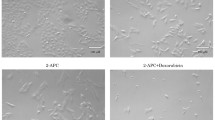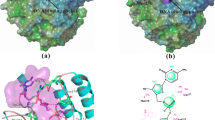Abstract
Purpose
The ERCC1–XPF 5′–3′ DNA endonuclease complex is involved in the nucleotide excision repair pathway and in the DNA inter-strand crosslink repair pathway, two key mechanisms modulating the activity of chemotherapeutic alkylating agents in cancer cells. Inhibitors of the interaction between ERCC1 and XPF can be used to sensitize cancer cells to such drugs.
Methods
We tested recently synthesized new generation inhibitors of this interaction and evaluated their capacity to sensitize cancer cells to the genotoxic activity of agents in synergy studies, as well as their capacity to inhibit the protein–protein interaction in cancer cells using proximity ligation assay.
Results
Compound B9 showed the best activity being synergistic with cisplatin and mitomycin C in both colon and lung cancer cells. Also, B9 abolished the interaction between ERCC1 and XPF in cancer cells as shown by proximity ligation assay. Results of different compounds correlated with values from our previously obtained in silico predictions.
Conclusion
Our results confirm the feasibility of the approach of targeting the protein–protein interaction between ERCC1 and XPF to sensitize cancer cells to alkylating agents, thanks to the improved binding affinity of the newly synthesized compounds.




Similar content being viewed by others
References
Li S, Lu H, Wang Z, Hu Q, Wang H, Xiang R, Chiba T, Wu X (2019) ERCC1/XPF is important for repair of dna double-strand breaks containing secondary structures. iScience 16:63–78. https://doi.org/10.1016/j.isci.2019.05.017
Zhang H, Chen Z, Ye Y, Ye Z, Cao D, Xiong Y, Srivastava M, Feng X, Tang M, Wang C, Tainer JA, Chen J (2019) SLX4IP acts with SLX4 and XPF–ERCC1 to promote interstrand crosslink repair. Nucleic Acids Res 47:10181–10201. https://doi.org/10.1093/nar/gkz769
Faridounnia M, Folkers GE, Boelens R (2018) Function and interactions of ERCC1–XPF in DNA damage response. Molecules 23:3205. https://doi.org/10.3390/molecules23123205
Heyza JR, Arora S, Zhang H, Conner KL, Lei W, Floyd AM, Deshmukh RR, Sarver J, Trabbic CJ, Erhardt P, Chan TH, Dou QP, Patrick SM (2018) Targeting the DNA repair endonuclease ERCC1–XPF with green tea polyphenol epigallocatechin-3-gallate (EGCG) and its prodrug to enhance cisplatin efficacy in human cancer cells. Nutrients 10:1644. https://doi.org/10.3390/nu10111644
McNeil EM, Melton DW (2012) DNA repair endonuclease ERCC1–XPF as a novel therapeutic target to overcome chemoresistance in cancer therapy. Nucleic Acids Res 40:9990–10004. https://doi.org/10.1093/nar/gks818
Cummings M, Higginbottom K, McGurk CJ, Wong OGW, Köberle B, Oliver RTD, Masters JR (2006) XPA versus ERCC1 as chemosensitising agents to cisplatin and mitomycin C in prostate cancer cells: role of ERCC1 in homologous recombination repair. Biochem Pharmacol 72:166–175. https://doi.org/10.1016/j.bcp.2006.04.025
Chang IY, Kim MH, Kim HB, Lee DY, Kim SH, Kim HY, You HJ (2005) Small interfering RNA-induced suppression of ERCC1 enhances sensitivity of human cancer cells to cisplatin. Biochem Biophys Res Commun 327:225–233. https://doi.org/10.1016/j.bbrc.2004.12.008
Arora S, Kothandapani A, Tillison K, Kalman-Maltese V, Patrick SM (2010) Downregulation of XPF-ERCC1 enhances cisplatin efficacy in cancer cells. DNA Repair (Amst) 9:745–753. https://doi.org/10.1016/j.dnarep.2010.03.010
Jordheim LP, Barakat KH, Heinrich-Balard L, Matera EL, Cros-Perrial E, Bouledrak K, El SR, Perez-Pineiro R, Wishart DS, Cohen R, Tuszynski J, Dumontet C (2013) Small molecule inhibitors of ERCC1–XPF protein–protein interaction synergize alkylating agents in cancer cellss. Mol Pharmacol 84:12–24. https://doi.org/10.1124/mol.112.082347
Gentile F, Elmenoufy AH, Ciniero G, Jay D, Karimi-Busheri F, Barakat KH, Weinfeld M, West FG, Tuszynski JA (2020) Computer-aided drug design of small molecule inhibitors of the ERCC1–XPF protein–protein interaction. Chem Biol Drug Des 95:460–471. https://doi.org/10.1111/cbdd.13660
Dietlein F, Thelen L, Reinhardt HC (2014) Cancer-specific defects in DNA repair pathways as targets for personalized therapeutic approaches. Trends Genet 30:326–339. https://doi.org/10.1016/j.tig.2014.06.003
Hill JM, Speer RJ (1982) Organo-platinum complexes as antitumor agents. (Review). Anticancer Res 2:173–185
Galluzzi L, Vitale I, Aaronson SA, Abrams JM, Adam D, Agostinis P, Alnemri ES, Altucci L, Amelio I, Andrews DW, Annicchiarico-Petruzzelli M, Antonov AV, Arama E, Baehrecke EH, Barlev NA, Bazan NG, Bernassola F, Bertrand MJM, Bianchi K, Blagosklonny MV, Blomgren K, Borner C, Boya P, Brenner C, Campanella M, Candi E, Carmona-Gutierrez D, Cecconi F, Chan FKM, Chandel NS, Cheng EH, Chipuk JE, Cidlowski JA, Ciechanover A, Cohen GM, Conrad M, Cubillos-Ruiz JR, Czabotar PE, D’Angiolella V, Dawson TM, Dawson VL, De Laurenzi V, De Maria R, Debatin KM, Deberardinis RJ, Deshmukh M, Di Daniele N, Di Virgilio F, Dixit VM, Dixon SJ, Duckett CS, Dynlacht BD, El-Deiry WS, Elrod JW, Fimia GM, Fulda S, García-Sáez AJ, Garg AD, Garrido C, Gavathiotis E, Golstein P, Gottlieb E, Green DR, Greene LA, Gronemeyer H, Gross A, Hajnoczky G, Hardwick JM, Harris IS, Hengartner MO, Hetz C, Ichijo H, Jäättelä M, Joseph B, Jost PJ, Juin PP, Kaiser WJ, Karin M, Kaufmann T, Kepp O, Kimchi A, Kitsis RN, Klionsky DJ, Knight RA, Kumar S, Lee SW, Lemasters JJ, Levine B, Linkermann A, Lipton SA, Lockshin RA, López-Otín C, Lowe SW, Luedde T, Lugli E, MacFarlane M, Madeo F, Malewicz M, Malorni W, Manic G, Marine JC, Martin SJ, Martinou JC, Medema JP, Mehlen P, Meier P, Melino S, Miao EA, Molkentin JD, Moll UM, Muñoz-Pinedo C, Nagata S, Nuñez G, Oberst A, Oren M, Overholtzer M, Pagano M, Panaretakis T, Pasparakis M, Penninger JM, Pereira DM, Pervaiz S, Peter ME, Piacentini M, Pinton P, Prehn JHM, Puthalakath H, Rabinovich GA, Rehm M, Rizzuto R, Rodrigues CMP, Rubinsztein DC, Rudel T, Ryan KM, Sayan E, Scorrano L, Shao F, Shi Y, Silke J, Simon HU, Sistigu A, Stockwell BR, Strasser A, Szabadkai G, Tait SWG, Tang D, Tavernarakis N, Thorburn A, Tsujimoto Y, Turk B, Vanden Berghe T, Vandenabeele P, Vander Heiden MG, Villunger A, Virgin HW, Vousden KH, Vucic D, Wagner EF, Walczak H, Wallach D, Wang Y, Wells JA, Wood W, Yuan J, Zakeri Z, Zhivotovsky B, Zitvogel L, Melino G, Kroemer G (2018) Molecular mechanisms of cell death: recommendations of the Nomenclature Committee on Cell Death 2018. Cell Death Differ 25:486–541. https://doi.org/10.1038/s41418-017-0012-4
Nirmala JG, Lopus M (2019) Cell death mechanisms in eukaryotes. Cell Biol Toxicol 36:145–164. https://doi.org/10.1007/s10565-019-09496-2
Elmenoufy AH, Gentile F, Jay D, Karimi-Busheri F, Yang X, Soueidan OM, Weilbeer C, Mani RS, Barakat KH, Tuszynski JA, Weinfeld M, West FG (2019) Targeting DNA repair in tumor cells via inhibition of ERCC1–XPF. J Med Chem 62:7684–7696. https://doi.org/10.1021/acs.jmedchem.9b00326
Elmenoufy AH, Gentile F, Jay D, Karimi-Busheri F, Yang X, Soueidan OM, Mani RS, Ciniero G, Tuszynski JA, Weinfeld M, West FG (2020) Design, synthesis and in vitro cell-free/cell-based biological evaluations of novel ERCC1–XPF inhibitors targeting DNA repair pathway. Eur J Med Chem 204:112658. https://doi.org/10.1016/j.ejmech.2020.112658
Labute P (2008) The generalized born/volume integral implicit solvent model: estimation of the free energy of hydration using London dispersion instead of atomic surface area. J Comput Chem 29:1693–1698. https://doi.org/10.1002/jcc.20933
Volpe A, Racioppi M, D’Agostino D, Cappa E, Filianoti A, Bassi PF (2010) Mitomycin C for the treatment of bladder cancer. Minerva Urol Nefrol 62:133–144
Florea A-M, Büsselberg D (2011) Cisplatin as an anti-tumor drug: cellular mechanisms of activity, drug resistance and induced side effects. Cancers (Basel) 3:1351–1371. https://doi.org/10.3390/cancers3011351
Oun R, Moussa YE, Wheate NJ (2018) The side effects of platinum-based chemotherapy drugs: a review for chemists. Dalt Trans 47:6645–6653. https://doi.org/10.1039/c8dt00838h
Arora S, Heyza J, Zhang H, Kalman-Maltese V, Tillison K, Floyd AM, Chalfin EM, Bepler G, Patrick SM (2016) Identification of small molecule inhibitors of ERCC1–XPF that inhibit DNA repair and potentiate cisplatin efficacy in cancer cells. Oncotarget 7:75104–75117. https://doi.org/10.18632/oncotarget.12072
McNeil EM, Astell KR, Ritchie AM, Shave S, Houston DR, Bakrania P, Jones HM, Khurana P, Wallace C, Chapman T, Wear MA, Walkinshaw MD, Saxty B, Melton DW (2015) Inhibition of the ERCC1–XPF structure-specific endonuclease to overcome cancer chemoresistance. DNA Repair (Amst) 31:19–28. https://doi.org/10.1016/j.dnarep.2015.04.002
Thomas AM, Brolih S, McGouran JF, El-Sagheer AH, Ptchelkine D, Jones M, McDonald NQ, McHugh PJ, Brown T (2019) Optimised oligonucleotide substrates to assay XPF-ERCC1 nuclease activity for the discovery of DNA repair inhibitors. Chem Commun 55:11671–11674. https://doi.org/10.1039/c9cc05476f
Chapman TM, Gillen KJ, Wallace C, Lee MT, Bakrania P, Khurana P, Coombs PJ, Stennett L, Fox S, Bureau EA, Brownlees J, Melton DW, Saxty B (2015) Catechols and 3-hydroxypyridones as inhibitors of the DNA repair complex ERCC1–XPF. Bioorgan Med Chem Lett 25:4097–4103. https://doi.org/10.1016/j.bmcl.2015.08.031
Basu AK, Hanrahan CJ, Malia SA, Kumar S, Bizanek R, Tomasz M (1993) Effect of site-specifically located mitomycin C-DNA monoadducts on in vitro DNA synthesis by DNA Polymerases. Biochemistry 32:4708–4718. https://doi.org/10.1021/bi00069a004
Acknowledgements
This research was partly supported by funds from the Alberta Cancer Foundation. FG was supported by an Alberta Innovates scholarship and a Novartis Pharmaceuticals Canada Inc. scholarship. LPJ received funding from Olav Raagholt og Gerd Meidel Raagholts stiftelse for forskning. The authors are grateful to Bruno Chapuis and Denis Ressnikoff at CIQLE, Lyon for valuable assistance in image acquisition and analysis.
Author information
Authors and Affiliations
Corresponding author
Ethics declarations
Conflict of interest
The authors have no conflict of interest to declare.
Additional information
Publisher's Note
Springer Nature remains neutral with regard to jurisdictional claims in published maps and institutional affiliations.
Rights and permissions
About this article
Cite this article
Ciniero, G., Elmenoufy, A.H., Gentile, F. et al. Enhancing the activity of platinum-based drugs by improved inhibitors of ERCC1–XPF-mediated DNA repair. Cancer Chemother Pharmacol 87, 259–267 (2021). https://doi.org/10.1007/s00280-020-04213-x
Received:
Accepted:
Published:
Issue Date:
DOI: https://doi.org/10.1007/s00280-020-04213-x




